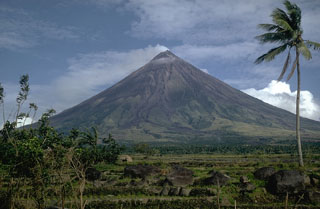Report on Mayon (Philippines) — August 1979
Scientific Event Alert Network Bulletin, vol. 4, no. 8 (August 1979)
Managing Editor: David Squires.
Mayon (Philippines) Seismic activity and crater glow
Please cite this report as:
Global Volcanism Program, 1979. Report on Mayon (Philippines) (Squires, D., ed.). Scientific Event Alert Network Bulletin, 4:8. Smithsonian Institution. https://doi.org/10.5479/si.GVP.SEAN197908-273030
Mayon
Philippines
13.257°N, 123.685°E; summit elev. 2462 m
All times are local (unless otherwise noted)
Seismic activity and crater glow were observed at Mayon 14-28 July. The same type of activity preceded the 1978 eruption. COMVOL has established a close watch on the volcano and will monitor any changes.
Geological Summary. Symmetrical Mayon, which rises above the Albay Gulf NW of Legazpi City, is the most active volcano of the Philippines. The steep upper slopes are capped by a small summit crater. Recorded eruptions since 1616 CE range from Strombolian to basaltic Plinian, with cyclical activity beginning with basaltic eruptions, followed by longer periods of andesitic lava flows. Eruptions occur predominately from the central conduit and have also produced lava flows that travel far down the flanks. Pyroclastic density currents and mudflows have commonly swept down many of the approximately 40 ravines that radiate from the summit and have often damaged populated lowland areas. A violent eruption in 1814 killed more than 1,200 people and devastated several towns.
Information Contacts: G. Andal, COMVOL, Quezon City; J. Wolfe, Pan Asean Technical Services, Manila.

